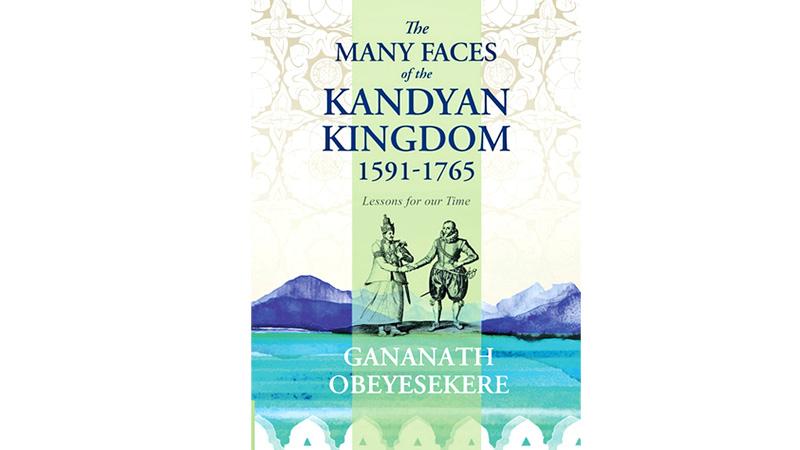
The Many Faces of the Kandyan Kingdom (1591-1765): Lessons for Our Time by Gananath Obeyesekere. 2020. Sailfish Publishers. ISBN: 978-955-7743-06-6. 200 pages. LKR 960.00
This monograph builds a fascinating narrative of the Kandyan kingdom and its kings. Many historians have written extensively on the Kandyan period. However, being an anthropologist, the author zooms into the Kandyan period through a different lens, illuminating the politics behind history writing and demonstrating the ‘non-conformist’ nature of the period.
Vimaladharmasuriya, the cosmopolitan king
Vimaladharmasuriya the First, the cosmopolitan king, shakes hands with foreign visitors, offers homemade wine to guests, and encourages foreign convicts to reside in Kandy. The monograph navigates across the time of the Kandyan period. Obeyesekere beautifully presents how Kandyan kings were cosmopolitan and allowed different faiths, ethnicities, and races to flourish in the kingdom.
Obeyesekere, in contrast to linear and one-sided popular historical narratives, explains the intricacies of the time. While some areas of the island were under Portuguese control, the Dutch competed with the Portuguese, and the English surfaced in Indian Ocean waters later, all having an impact on the country. As a result, the island's social fabric became ‘messy’ and complicated over time with the changing political and economic conditions.
In contrast to the ways Sinhala rulers are depicted in school history books, Vimaladharmasuriya the First was bold and relaxed. He was beyond today's 'Sinhala-Buddhist' mentality. The King had a vineyard. According to Dutch records, the King carried a golden cup filled with wine and served the distinguished guests. The King's children were clothed in ‘Christian’ attire and foreign guests were permitted to enter the inner chambers to meet with the royal family.
The book recounts a brief description of Vimaladharmasuriya's childhood, where he was raised as a Buddhist – Konoppu Bandara – before being taken to Goa as a young exile, baptised as Don Joao, and officially recognised as a Catholic. This complex history peels back the layers of the country's social and political fabric. Religious identities were not always clearly defined, but were muddled and hazy—the author analyses how people became nominal Christians but remained Buddhist in their hearts. People adopted Jesus to their religious cosmos, similar to how one of the Hindu and Buddhist gods, Pattini was transformed into Virgin Mary by local Catholics.
Cosmopolitan Kandy and religious freedom
Dutch records depict the dynamic social environment of the Kandyan metropolis, where many ethnic and religious groups coexisted, yet each had its own set of rules. The archives also show that the King's army included soldiers from a variety of religious and ethnic origins, including Turks, Moors, Sinhalese, and Kaffirs, as well as renegade Portuguese. Kandy was teeming with well-heeled and well-dressed nobility. Some city folk wore a cap on their heads, while others made a headpiece out of their hair. Their bodies were decked with expensive stone jewellery.
The townies were well-dressed both physically and aesthetically. The city dwellings were stunning and well-built. The Kandyan kingdom was a melting pot of languages. To engage in trade, one needed to be fluent in Portuguese and Tamil. Kings and nobles were fluent in both languages. The kings and nobles communicated with foreign missions using Portuguese or Tamil. This was of course in addition to their command of the Sinhala language.
Catholic missions
Eventually, the Portuguese lost their power over the island, and the Dutch took over the control of maritime areas. As soon as the Portuguese were expelled from the island, the Dutch made significant strides to obliterate Portuguese vestiges, and as a result, Ceylon Catholics faced merciless persecution. Father Joseph Vaz of the Oratory Mission came to Lanka with the expressed mission to protect Catholicism, and most Catholics responded to the ruthless Dutch suppression by fleeing to Kandyan provinces. There, Kandyan kings offered them freedom of faith.
Playful King Narendrasinha
The tale of King Narendrasinha is enthralling. During King Narendrasinha's reign, he was friends with numerous religious luminaries, including Catholics, Buddhists, and Hindus. He closely associated with father Joseph Vaz and father Jacome GonÇalvez. According to the author, it is not easy to assume that the monarch did not regularly interact with the Buddhist samaneras in his court. Being a monarch, he had to consult Brahmin purohithas too.
The King renovated the Palace of the Tooth Relic and built a two-story structure. Because of his love of poetry and the arts, the monarch was dubbed "the playful king" or sellam rajjuruwo. The name sellam rajjurowo, on the other hand, has another connotation: sensuality. This seductive allure was displayed in the form of dancing ladies accompanied by drumming and singing who regularly performed in his court.
The politics of history writing
The book presents Kandyan kings and the functioning of the Kandyan kingdom as an alternative to present-day insular political practices. However, beyond setting the ideal example of cosmopolitanism, the author also showcases the politics behind history writing. The book revisits the Kandyan kingdom through another route to Sri Lankan history: the Dutch records. Without limiting himself to local narratives only or more recent problematic popular interpretations, Obeyesekere’s research looked to the Dutch archives to gain a new perspective on the Kandyan kingdom. Ironically, the cosmopolitan, multi-religious, multi-lingual, and joyful character of Kandy or the Kandyan kings has been lost in local history writing, conditioned by a recently constructed 'Sinhala-Buddhist' politico-cultural ethos.
The writer is a Doctoral Candidate in the School of Social Sciences, University of Otago.
